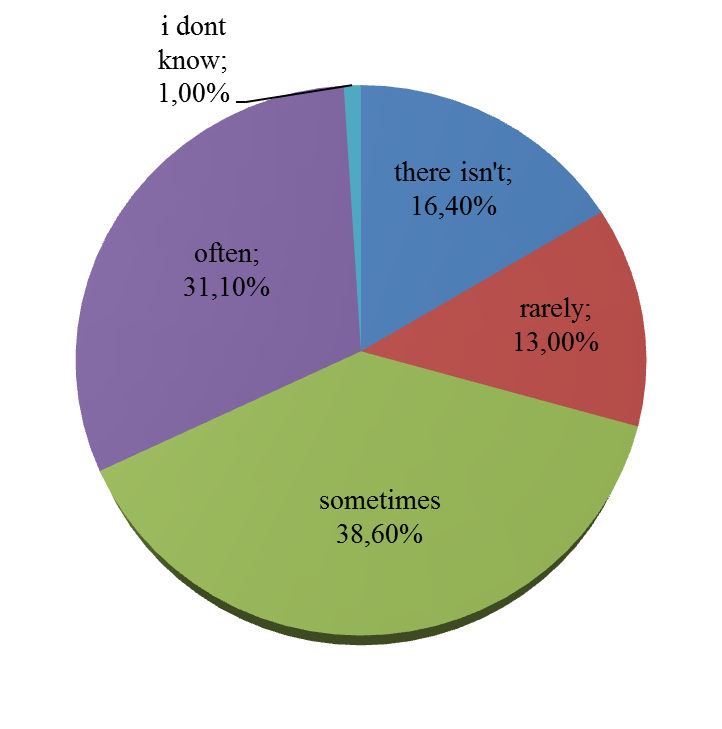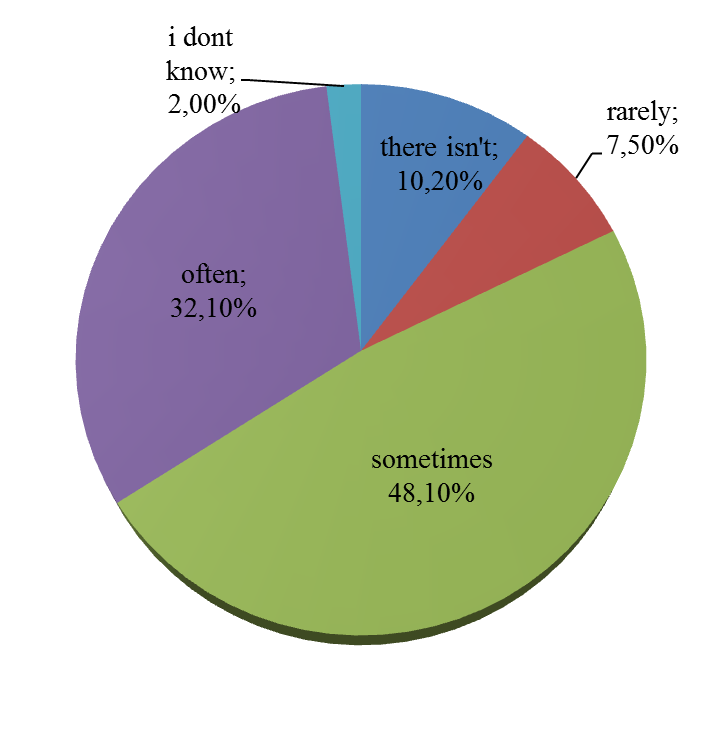Abstract
Classrooms in school often do not benefit from their own acoustic which constitutes an essential factor in implementing elements with an important role in the social and emotional development of the primary school child. The classroom is the place where the child spends his learning time while at school and occasionally this medium is changed with better acoustic spaces like theatre halls or cinema halls. Even though studies in this area show a high interest on the importance of acoustics in classrooms, the interest displayed from both specialists and the state administration, in Romania relevant regulations are not relative to the current needs of the contemporary education system. The main focus of teachers is to provide children with the best environment and tools for learning in specific accommodating conditions, even though these conditions are often hard to accomplish. Since the development of social and emotional development depends on the external factors along with the internal factors, a necessity for accomplishing a natural environment of learning is the main goal. The research conducted in this paper aims to show correlations between acoustics of a classroom and its implications in the context of social and emotional development of primary school children. The research was conducted in a state school in Cluj-Napoca, Romania.
Keywords: Classroom acousticssocial and emotional developmentlearning conditionschild education
Introduction
A few notes on classroom arrangements
Classrooms, in the public schools of Romania, almost always look the same: a room with a black/white board in front, windows on one side of the room, rows of two or three desks in a line, seldom cabinets on the side or at the back of the room and the teacher always has the desk in front of the children. This wouldn’t constitute a problem if the room was properly ventilated, big enough to accommodate the children or would be fitted with the proper teaching instruments. There is always a problem with the number of desks in one classroom and the number of children, which in many cases exceed the number allowed in a classroom to function in optimal conditions. The teacher has to struggle to be understood and the children are having a hard time concentrating. Knowing the child’s interest for learning, in primary school a child can be at times too loud or to eager to find out right then the information he’s looking. This can be problematic as the teacher has to interrupt the lessons and continue to explain on the point of interest and this is not a desirable situation. Most teachers manage to control a proper classroom environment and teach the proposed information for the school day.
The classroom in itself should be a tool that the teacher could use in his/hers and the children’s advantage. The way the furniture and informational material is arranged, but also the way the room is structured and build is an important factor for teaching lessons in the classroom. Most schools in Romania do not have the required materials to support the teacher in his/hers teaching endeavours. If the teacher isn’t having the proper material support then he/she can’t hold his/hers lessons accordingly and this results in a frustrated child and incomplete information delivery. The social and emotional development of the child starts at the very beginning and is a process that lasts through his years of school and with the suitable upbringing and the appropriate informational transfer the child can become a person with developed social and emotional skills needed in his/hers strife in life.
Room acoustics and legislative regulations
An important aspect of the classroom is the acoustics of the room the lessons are being held. There is a concern regarding the acoustics of the classroom in various countries: Finland, Iceland, Germany, Portugal, India etc. According to the “Handbook on the Implementation of EC Environmental Legislation” environmental noise constitutes an issue in the European Community and the number of people that suffer from this problem is large and increasing with each year (Regulations concerning noise protection). In Romania STAS 6161-3 and STAS 6156-86 has the following requirements for sound levels in regards to functional units in buildings for educational purposes (see Table
Classroom acoustics
Recent studies suggest that regulations are not properly used in order to confer a decent indoor noise level and therefore acoustics for the teaching process. A study was carried out in Nagao, India to determine if the noise pollution is contributing to the negatively performance of students and teachers. It was determined that all the buildings where teaching-learning processes were performed were not suitable for this kind of process and that road traffic was a major problem and contributed in a vast majority to this aspect (Debnath et al., 2012).
Sound levels are not always an exterior factor and a comparison between public preschools and a “tighter pedagogical control of discipline” affirmed that the noise levels are different, in a sense that in public preschools noise levels made by children were much higher than the other school system. This also reported that the teachers in the public school were more fatigued and didn’t have such a good control over the children noise productions (Jonsdottir et al.,2015). There is a difference for the noise levels between the types of schools. In primary schools the levels of noise is higher than in secondary schools and so the primary school children are more affected by the noise levels than other pupils (Bhardwaj et al., 2013). Using measurements of sound levels, reverberation time in classroom and sound insulation a study determined that a number of schools don’t embrace the requirement for good acoustical classrooms (Pinho et al., 2016). The study also acknowledged that only two of the eight buildings tested had the required acoustic.
The learning process is very much influenced if the teacher is being heard even from the back of the classroom by the children. The classroom surfaces and floors create the proper or improper environment needed in the classroom. If these are not made by the right materials the sound can reverberate more than necessary and create annoyance or distractions. It was found that carpets on the floors were a positive aspect and shaped the room as suitable for learning functions (Pääkkönen et al., 2015). In the teaching process not only the child has to suffer from improper acoustics of the classroom but also the teacher as well. Teachers that must undertake teaching tasks in a poorly ventilated or inappropriate acoustical room have more voice organ problems than others. The result of one study suggests that indoor environment influences the voice and therefore resulting in health problems (Rantala et al., 2015).
The teacher has to make effort in order to be understood in a classroom with young children and it was found that the levels of speech intelligibility vary between different ages. First grade pupils require with 7 dB better speech-to-noise ratios than grade 6 students (Bradley & Sato, 2008). An interdisciplinary study has proved the importance of good acoustics in the classroom and the team consisting of acousticians, occupational health scientists and pedagogues measured the communication behaviour relative to classroom acoustic measurements in two elementary schools. In a classroom with fitting acoustics provide high absorption of noise and high speech intelligibility and this translates to teacher and children alike don’t have to talk aloud to be heard or understood (Tiesler et al., 2015).
Problem Statement
When a teacher is heard he/she can make lesson more fun and interesting and doesn’t have to worry about not being understood or not delivering the information to his/her pupils. In accordance children can properly learn all that is being taught and can exchange ideas in an orderly fashion. The acoustics of the room provides an important quality and so the pupil doesn’t have to worry if he’s being too loud.
Research Questions
According to the research question we expected to find the levels of noise in the classroom and the sources of noise in the school building. One main interest was the impact the noise has on children and how it affects them during school classes and how children deal with these interferences caused by room acoustics and school building construction.
Purpose of the Study
The current study tried to establish the intensity of noise in primary school classrooms and also in the school among primary school children. We have studied the presents of sound and its source and identified actions that the children might take in order to reduce such noise.
Research Methods
Participants
We have contacted primary school teachers at a school in Cluj-Napoca about the intention of the study and there were willing to cooperate. The study was applied to 293 primary school children (Nfemale=159, Nmale=134) with ages between 8 and 12 with Mage=9.369 years (Mage female=9.37, Mage male=9.36). The children were from three levels of grades in the Romanian school system: second, third and fourth.
Design
A semi-structured questionnaire was design with ten closed single-option answers and at the end there was an open-ended question. The questionnaire was implemented during break hours in school days and it didn’t interfere with the classroom schedule of teaching. All children answered the questionnaire in their own time, there was no timing and they all marked their answer individually with no collaboration from their peers. The ten closed single-option answers were analysed descriptively and for the last question there were themes identified and then categorized in six separate themes accordingly.
Results
The data collected were entered and were processed using the SPSS statistical software. Below, we present a visual summary for the answers of the questionnaire that was applied.
Questions three and four regarded the levels of noise in the classroom and in the school and the results are as follows. The results revealed that 10.2%of children think that there isn’t noise in the school, 7.5% think there is rarely noise, 48.10% there is sometimes noise at school and 32.10% answered that there is often noise in the school. Concerning the noise in the classroom 16.4% answered that there isn’t noise, 13% think there is rarely any noise, 38.6% answered that there is sometimes noise and 31.1% think there is often noise in the classroom. (see Figure


The next two questions were about the sources of noise during class hours and also during break time. Result show that during class hours 41.6% think the noise is produced by their classmates, 50.2% think the noise is from outside sources, 2.7% answered that the noise is from other classroom and 5.1% think the source of the noise is from elsewhere. During break time 47.8% think the noise is made by their classmate, 8.5% of the children have answered that noise is from other classrooms and 6.8% think the noise comes from elsewhere (see table
The results for question seven concerning how does noise make them feel when it occurs are presented in table

The results for the question regarding their well-being were divided by age and the answers are as follow in Figure

Considering the last question where the children were asked to give solutions to noise problems, we analysed the answers qualitatively and divided the answers into six themes (categories). The results are illustrated in table
Findings
The result of the current paper produced answers to the important questions of the current research. It displays the presents of the noise, the intensity and also the sources of the noise in the classroom and also in the school. The majority of the children stated that the noise is present both in the classroom and in the school during class hours and most specifically during break time. This indicates that the children are aware of the noise that is around them. Concerning the sources of the noise half of the children think the noise comes from outside their classroom or their classmates. This also applies to the noise that the classmates make in the classroom during break time. Most children can’t concentrate when noise if present and noise bothers them. Even though more males think that noise doesn’t bother them, when it comes to disturbance both female and male think that noise is a disturbance. More female participants think that noise make hard for them to hear the teacher during class hours. When age was discussed it was reported that younger children and older children can’t concentrate during class hours. The younger children were the ones who were the most disturbed by the noise during class hours and break time. According to the children’s opinions the well-being isn’t something that is influenced that much by the noise in school or in the classroom. The younger children were the ones who thought that noise doesn’t influence them in regards their well-being during school hours. Maybe this is due to the fact that the noise isn’t something that occurs that often during class hours and overall they don’t feel that they are threatened by the noise levels even though they admit that they either can’t concentrate or they can’t hear their teacher when she’s holding the classes and the noise occurs from outside or their classmates. When it comes to solutions for the noisy situations children gave a handful. Most of them said that everyone should comply with the rules for silence of less noise, other for initiative for themselves to keep quiet and also a majority think they would tell their colleagues to keep the noise level down when making noise above of what they consider normal levels. The results for this question also revealed that there is a concern in regards with the construction of their classroom and many of them think that the windows and doors of their classroom should be replaced by noise cancelling ones. The children are also in favour of punishments for the ones that make noise and disturbed the classroom when the noise isn’t necessary or unfit for class hours.
Conclusion
Noise is something that occurs in all aspects of life for children and also for adults. If the acoustics of the room/classroom are not suitable for a proper sound noise can be, as we saw in the current study a disturbing factor. The school children are the one that admitted that they are affected by noise and they were also the ones that instructed about the solutions to be undertaken to level the noise. More than often the noise occurs without them being involved and here we can make a few adult decisions and control the sound levels. The noises interfere with the well-being of the children even if they know of this or not.
One limitation of the current research was that the children from only one school were participants to the study and in the future we should consider also other schools to widen the area of research.
A future study should concentrate on the measurements of noise levels in the classrooms and around the school area of multiple schools to determine if the noise levels are in accordance with the requirements and if the levels of proper sounds are achieved with better room acoustics.
Acknowledgments
I would like to thank the professors’ staff at the Doctoral School Education, Reflection, Development, Babes-Bolyai University. Also, I would like to thank the management staff, teachers and participants from “Onisifor Ghibu” - High school in Cluj-Napoca.
References
- Bhardwaj, M., Baum, U., Markevych, I., Mohamed, A., Weinmann, T., Nowak, D., Radon, K. (2013). Are primary school students exposed to higher noise levels than secondary school students in Germany? Int J Occup Environ Med, 4, 211. Retrieved from http://www.theijoem.com/ijoem/index.php/ijoem/article/view/185/322
- Bradley, J., Sato, H. (2008). The intelligibility of speech in elementary school classrooms. J Acoust Soc Am. 123(4), 2078-2086. doi: 10.1121/1.2839285.
- Debnath, D., Nath, S.K., Barthakur, N.K. (2012). Environmental Noise Pollution in Educational Institutes of Nagaon Town, Assam, India. Global Journal of Science Frontier Research Enviornment & Earth Sciences 12(1) Version 1.0. Retrieved from https://journalofscience.org/index.php/ GJSFR/article/view/703
- Handbook on the Implementation of EC Environmental Legislation. (2014). Noise Legislation. Retrieved from http://ec.europa.eu/environment/archives/enlarg/pdf/handbook/handbook.htm
- Jonsdottir, V., Rantala, L.M., Oskarsson, G.K., Sala, E. (2015). Effects of pedagogical ideology on the perceived loudness and noise levels in preschools. Noise Health, 17, 282293. Retrieved from http://www.noiseandhealth.org/text.asp?2015/17/78/282/165044
- Pääkkönen, R., Vehviläinen, T., Jokitulppo, J., Niemi, O., Nenonen S., Vinha, J. (2015). Acoustics and new learning environment – A case study. 100, 74-78. doi: 10.1016/j. apacoust.2015.07.001
- Pinho, P.G., Pinto, M., Almeida, M.S.F., S.M. Lopes, S.M., Lemos, L.T. (2016). Aspects concerning the acoustical performance of school buildings in Portugal. Applied Acoustics, 106, 129-134. doi: 10.1016/j.apacoust.2016.01.002
- Rantala, L., Sala, E. (2015). Associations between Classroom Conditions and Teacher's Voice Production. 78, 3120-3125. Energy Procedia. doi: 10.1016/j.egypro.2015.11.767
- Tiesler, G., Machner, R., Brokmann, H. (2015). Classroom Acoustics and Impact on Health and Social Behaviour. Energy Procedia, 78, 3108-3113. doi: 10.1016/j.egypro.2015.11.765
- University Of Architecture And Urbanism "Ion Mincu" - Uauim Bucharest. Normativ Privind Protecţia La Zgomot [Regulations concerning noise protection]. Retrieved from http://www.ursa.ro/ro-ro/arhitecti/Documents/Standarde%20si%20Normative/06%20normativ_privind_protectia_la_zgomot.pdf
Copyright information

This work is licensed under a Creative Commons Attribution-NonCommercial-NoDerivatives 4.0 International License.
About this article
Publication Date
28 June 2018
Article Doi
eBook ISBN
978-1-80296-040-2
Publisher
Future Academy
Volume
41
Print ISBN (optional)
-
Edition Number
1st Edition
Pages
1-889
Subjects
Teacher, teacher training, teaching skills, teaching techniques, special education, children with special needs
Cite this article as:
Simion, A. (2018). Classroom Acoustics In The Social And Emotional Development Of Primary School Children. In V. Chis, & I. Albulescu (Eds.), Education, Reflection, Development – ERD 2017, vol 41. European Proceedings of Social and Behavioural Sciences (pp. 92-100). Future Academy. https://doi.org/10.15405/epsbs.2018.06.11

